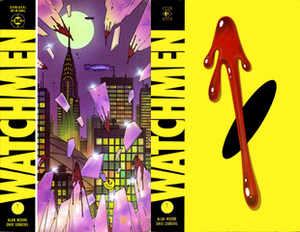Back in the 1980s, Comics Buyer’s Guide ran a cartoon depicting two stalwart Marvel heroes,
Daredevil and Nightcrawler, in a wrestling match. The caption read, “Mindless violence as you
like it!”
The cartoon poked fun at the tendency of some fans to prefer
violence over any kind of plot, character development, or theme—the elements most
of us think of as “story,” and which writers love to write.
The irony is that, in the three decades or so since that
cartoon ran, mindless violence has escalated in comics, films and TV, and
especially video games. One recent book goes so far as to pin the blame for the horrific trend of mass shootings on the rapes, murders, and carnage our children are
exposed to in modern video games.
This is not the place to argue the pros and cons of that
debate. However, for many fans of super-heroes, violence—or, to use a less
inflammatory term, “action”—is a significant part of the genre’s appeal.
Think of any Spider-Man, Avengers, or Batman film, or
even non-super-hero blockbusters such as Mission:
Impossible and The Matrix. What’s the first scene that comes to your
mind? Chances are, it involves some kind
of violence or action.
(For me, the first scene in Marvel’s The Avengers
which springs to mind involves the Hulk—the green-skinned epitome of mindless violence—and
his famous “Puny god!” line. Mindless
violence? Perhaps. But funny as all get out.)
Cut to the (Car) Chase?
A conversation with two friends today got me thinking about
the role of action in super-hero stories.
One friend in his early 50s said he watches super-hero films and reads comics solely for the action. He has no interest in story lines. He wants car chases and explosions.
(This friend, by the way, has never to my knowledge gone on
a mass shooting spree. He’s a devoted family man who recently won the employee
of the year award at his job and who spends his free time teaching kids how to
draw.)
The other friend, same age, likes a balance between story
and action. He took the Transformers movie to task because, once
the characters transformed and started fighting each other, he couldn’t tell
who was who.
Then there’s me. I’ve largely moved on from comics
these days, though I still love a good super-hero story. (Avengers
was one of the truest comics-to-film adaptations I’ve ever seen and an
enjoyable movie in its own right.) However, if given a choice, I’ll prefer story to action every time.
My most recent favorite TV series, Downton Abbey, is about as
far removed from super-hero action as you can get.
Without a good story, action does not satisfy me.
Heroes and the High Cost of Violence
Our conversation, in turn, got me thinking about the role of
action in my own super-hero stories, especially the two available through the links
at the top of this blog: the comic book GOLD
DUST and the novel THE POWER CLUB.
If you’re looking for slam-bang, wall-to-wall action, pass on both of
these. That isn’t to say there’s no action in either—there is—but the action
supports the other elements I described above (plot, character, and theme); it does not take their place.
By keeping action to a minimum and using it only when
necessary, I sought to achieve a particular effect: to make violence more
significant, memorable, and (in a few cases) horrifying.
GOLD DUST, for example, is about a hero seeking redemption. Mangold,
in a flashback sequence, seeks revenge for the murder of his teammate by trying to kill a super-villain. He misses
and kills a bystander instead.
From
that moment on, Mangold tries to reclaim what he has lost: the sense of being a
hero, of making a positive impact on the world, and to win back the trust of
the people he protects.
The present-day action in GOLD DUST largely figures in
two scenes, one involving a mugging and the other a burning building. Both end
with our hero behaving in a somewhat less-than-heroic fashion.
My purpose was to show that the world is no longer as
cut-and-dried as Mangold wants it to be and that sometimes even heroes need
help.
My larger goal was to get readers to question the nature of
heroism and to recognize that, while heroes are flawed, they remain heroes
because they keep trying.
If I had to sacrifice a car chase or a punch-‘em-out with a
super-villain to achieve that effect, so be it.
Was I successful? I
don’t know. However, no one has ever complained to me that the story needs more action.
Action Does Not Equal Conflict
Besides, physical action is not as fun to read, in my opinion, as interpersonal or internal conflict. Mangold butts heads with his surviving teammates, who have also had
to pay a heavy price for his mistake. He also wages war with his own demons while trying to come to terms with what he has done.
Do these ideas resonate with readers today, or should I have
had Mangold and crew gang up on a group of super-villains instead? What do you think?
(In a future blog post, I’ll discuss the action in THE POWER
CLUB.)








